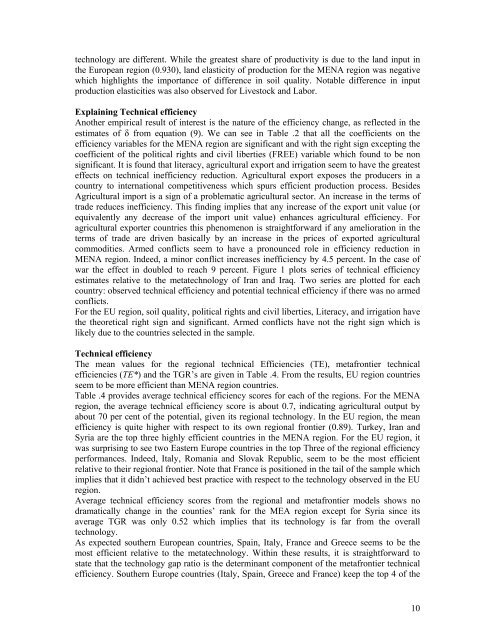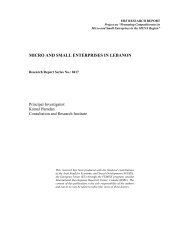Agricultural Productivity and technological gap between MENA ...
Agricultural Productivity and technological gap between MENA ...
Agricultural Productivity and technological gap between MENA ...
Create successful ePaper yourself
Turn your PDF publications into a flip-book with our unique Google optimized e-Paper software.
technology are different. While the greatest share of productivity is due to the l<strong>and</strong> input inthe European region (0.930), l<strong>and</strong> elasticity of production for the <strong>MENA</strong> region was negativewhich highlights the importance of difference in soil quality. Notable difference in inputproduction elasticities was also observed for Livestock <strong>and</strong> Labor.Explaining Technical efficiencyAnother empirical result of interest is the nature of the efficiency change, as reflected in theestimates of δ from equation (9). We can see in Table .2 that all the coefficients on theefficiency variables for the <strong>MENA</strong> region are significant <strong>and</strong> with the right sign excepting thecoefficient of the political rights <strong>and</strong> civil liberties (FREE) variable which found to be nonsignificant. It is found that literacy, agricultural export <strong>and</strong> irrigation seem to have the greatesteffects on technical inefficiency reduction. <strong>Agricultural</strong> export exposes the producers in acountry to international competitiveness which spurs efficient production process. Besides<strong>Agricultural</strong> import is a sign of a problematic agricultural sector. An increase in the terms oftrade reduces inefficiency. This finding implies that any increase of the export unit value (orequivalently any decrease of the import unit value) enhances agricultural efficiency. Foragricultural exporter countries this phenomenon is straightforward if any amelioration in theterms of trade are driven basically by an increase in the prices of exported agriculturalcommodities. Armed conflicts seem to have a pronounced role in efficiency reduction in<strong>MENA</strong> region. Indeed, a minor conflict increases inefficiency by 4.5 percent. In the case ofwar the effect in doubled to reach 9 percent. Figure 1 plots series of technical efficiencyestimates relative to the metatechnology of Iran <strong>and</strong> Iraq. Two series are plotted for eachcountry: observed technical efficiency <strong>and</strong> potential technical efficiency if there was no armedconflicts.For the EU region, soil quality, political rights <strong>and</strong> civil liberties, Literacy, <strong>and</strong> irrigation havethe theoretical right sign <strong>and</strong> significant. Armed conflicts have not the right sign which islikely due to the countries selected in the sample.Technical efficiencyThe mean values for the regional technical Efficiencies (TE), metafrontier technicalefficiencies (TE*) <strong>and</strong> the TGR’s are given in Table .4. From the results, EU region countriesseem to be more efficient than <strong>MENA</strong> region countries.Table .4 provides average technical efficiency scores for each of the regions. For the <strong>MENA</strong>region, the average technical efficiency score is about 0.7, indicating agricultural output byabout 70 per cent of the potential, given its regional technology. In the EU region, the meanefficiency is quite higher with respect to its own regional frontier (0.89). Turkey, Iran <strong>and</strong>Syria are the top three highly efficient countries in the <strong>MENA</strong> region. For the EU region, itwas surprising to see two Eastern Europe countries in the top Three of the regional efficiencyperformances. Indeed, Italy, Romania <strong>and</strong> Slovak Republic, seem to be the most efficientrelative to their regional frontier. Note that France is positioned in the tail of the sample whichimplies that it didn’t achieved best practice with respect to the technology observed in the EUregion.Average technical efficiency scores from the regional <strong>and</strong> metafrontier models shows nodramatically change in the counties’ rank for the MEA region except for Syria since itsaverage TGR was only 0.52 which implies that its technology is far from the overalltechnology.As expected southern European countries, Spain, Italy, France <strong>and</strong> Greece seems to be themost efficient relative to the metatechnology. Within these results, it is straightforward tostate that the technology <strong>gap</strong> ratio is the determinant component of the metafrontier technicalefficiency. Southern Europe countries (Italy, Spain, Greece <strong>and</strong> France) keep the top 4 of the10
















